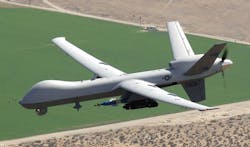Progress toward enabling manned and unmanned aircraft to share common airspace slow but encouraging
MUNICH, Germany, 21 March 2012. Transforming the world's air traffic control (ATC) systems to accommodate commercial and military aircraft, as well as unmanned aerial vehicles (UAVs) is proceeding, but is proving to be difficult, says the military representative to the European air traffic management (ATM) authority EUROCONTROL.
Progress to integrating manned and unmanned aircraft in shared airspace has been slow, and predictions about when manned and unmanned aircraft integration may occur have been unreliable, says Brig Gen. Hans-Georg Schmidt, vice commander of the 1st German Air Division, and the elected chairman of the Military Air Traffic Management Board of EUROCONTROL.
Schmidt made his comments today at the Avionics Europe 2012 conference and trade show in Munich, Germany, sponsored by Avionics Intelligence and PennWell.
Commercial and military aviation officials by nature are risk-averse and security-conscious, so they have been reluctant to allow manned and unmanned aircraft to operate in shared airspace. Typically UAVs operate in segregated military airspace in which conflicts with civil aircraft are rare, Schmidt told Avionics Europe 2012 attendees.
The avionics and ATM industries must meet several challenges before manned and unmanned aircraft can share non-segregated airspace safely and efficiently, Schmidt says.
First is an effective capability for UAVs to sense and avoid other aircraft. Traditionally the last line of defense for avoiding mid-air collisions has been the ability for human pilots to recognize potential conflicts with nearby aircraft and to make evasive maneuvers, when necessary.
Schmidt emphasizes that human UAV ground controllers must have the capability to intervene on a UAV's flight plan at any time to avoid conflicts with other manned and unmanned aircraft.
UAVs must have on-board sensors, signal processing, and software algorithms to do the same thing, and UAV ground controllers also must have real-time communications and data-linking capability to help UAVs sense and avoid other aircraft, Schmidt says. In addition, UAVs must have the ability to sense and avoid so-called "non-radiating" aircraft such as balloons and ultralights that do not show up on air traffic control radar.
Second, reliable data uplinks and downlinks for voice and digital information transmissions are necessary to connect UAVs, UAV ground controllers, and air traffic controllers reliably in real time to enable pilots and UAV ground controllers to work together to avoid conflicts and plan the most direct and efficient flight routes through crowded airspace.
Complicating matters in the transition to shared airspace among manned and unmanned aircraft is a scarcity of available radio frequencies for RF voice and data links -- particularly in Europe -- Schmidt points out.
Despite these challenges, however, Schmidt says aviation authorities can learn from the military's experiences of integrating military and commercial aircraft in shared airspace. Many of the difficult issues of enabling civil and military aircraft with vastly different flight capabilities in the same airspace could be applied to integrating manned and unmanned aircraft, Schmidt says.
The Avionics Europe 2012 conference takes place on Wednesday and Thursday this week. Follow continuing news coverage from the show on the Avionics Intelligence Website at www.avionics-intelligence.com/avionics-europe.
Follow Military & Aerospace Electronics and Avionics Intelligence news updates on Twitter
